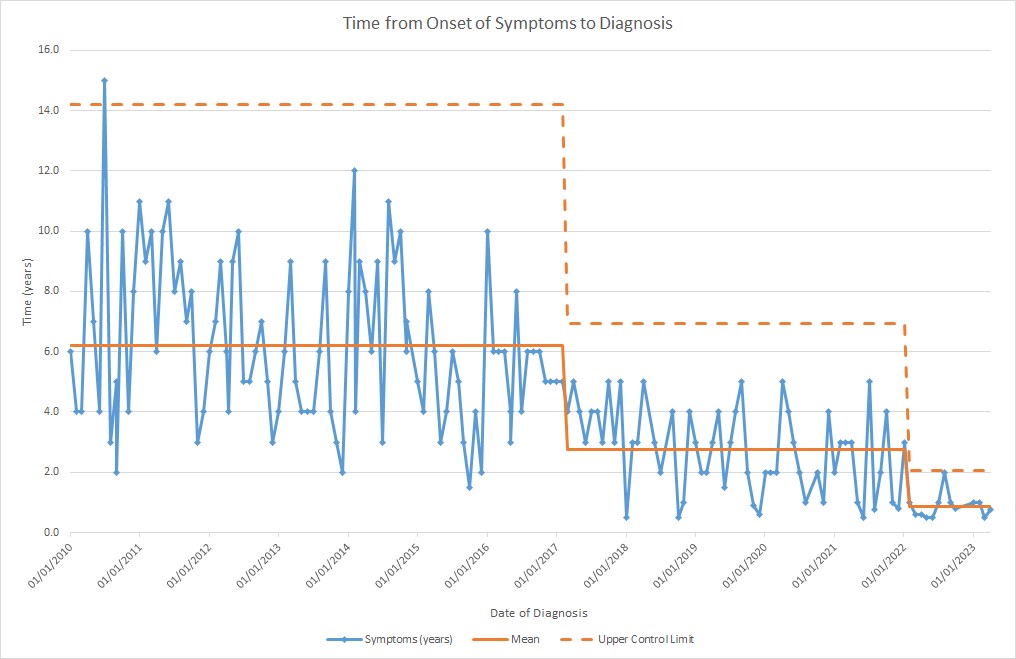Session Information
Session Type: Poster Session B
Session Time: 9:00AM-11:00AM
Background/Purpose: Early diagnosis of axial spondyloarthritis (AxSpA) remains a challenge in the management of this condition worldwide. Over the last decade, there remains a significant delay in the diagnosis of the condition. The delay is 8-10 years from symptom onset in Europe. This is contributed by the lack of awareness of the condition, unstructured referral pathways and limited access to diagnostic tests such as MRI. The delayed diagnosis leads to increased complications from AxSpA, delays in treatment and poorer long-term outcomes. Multiple referral strategies are available with the aim of improving the time to diagnosis of AxSpA.
Methods: We reviewed the time from symptom onset to diagnosis of the axial spondyloarthritis over a 12-year period from 2010 to 2023. During this time, we evaluated the effectiveness of the referral strategies we had put in place for use by general practitioners (GPs) to reduce the time to diagnosis. A baseline audit was carried out between January to August 2013 to help understand existing delivery levels against the key National Institute of Clinical Excellence (NICE) recommendations. From 2017, the ASAS referral criteria for suspected AxSpA was implemented in primary care1. This was available as an electronic referral from GPs to the AxSpA clinic. Educational and training events were held to improve the use of the ASAS referral criteria. Follow-up audits were carried out between February to July 2017, January to May 2019 and January to March 2023 to assess the impact of the implementation of the referral strategy with the local AxSpA best practice pathway. Data on length of time of symptoms before seeing the GP, time to referral and diagnosis were captured.
Results: We studied 160 axSpA patients, 87 (54.5%) were male and 73 (45.5%) female. The mean (range) age was 37 (18-52) years. All patients met the ASAS classification criteria for axSpA. Radiographic axSpA (Ankylosing spondylitis) fulfilled the modified New York criteria. There were more patients with radiographic axSpA in the earlier years of diagnosis (100% in 2010) and more of non-radiographic axSpA in the later years (85% in 2022). HLA-B*27 positivity was found in 118 (73.8%) of patients. The majority of referrals were from general practitioners 96 (60.2%), physiotherapists 32 (20.3%), orthopaedics 18 (15.5%) and other specialties 6 (4%). There was no significant difference in the mean (years) delay to diagnosis from the source of the clinic referral. The mean and median delay for time to diagnosis in years were in 2011 (8, 8.5), 2014 (7.8, 8), 2017 (4.2, 4), 2020 (2.5, 2), 2022 (1.1, 0.9) (Figure 1). The majority of the patients were diagnosed between 31-40 years (41%), 22% between 18-30 years, 31% between 41-50 years and 4% after the age of 50 years. We have managed to reduce mean time to diagnosis from a mean of 8 years (2011) to 1.1 years (2022).
Conclusion: The use of the ASAS referral criteria for suspected AxSpA together with increased educational and awareness campaign of its use in primary care and musculoskeletal triage has led to the earlier recognition and referral for suspected AxSpA.
References
Poddubnyy D, van Tubergen A, Landewé R, et al. Ann Rheum Dis 2015;74:1483–1487
To cite this abstract in AMA style:
Chan A, Rigler K, McDougall A. The Use of the ASAS Referral Criteria Together with Increased Education and Training of Its Use Improves Delay to Diagnosis of Axial Spondyloarthritis [abstract]. Arthritis Rheumatol. 2023; 75 (suppl 9). https://acrabstracts.org/abstract/the-use-of-the-asas-referral-criteria-together-with-increased-education-and-training-of-its-use-improves-delay-to-diagnosis-of-axial-spondyloarthritis/. Accessed .« Back to ACR Convergence 2023
ACR Meeting Abstracts - https://acrabstracts.org/abstract/the-use-of-the-asas-referral-criteria-together-with-increased-education-and-training-of-its-use-improves-delay-to-diagnosis-of-axial-spondyloarthritis/

